With OS2mo, public services can keep contact details and other information related to employees and their place in the organisation up to date, using authoritative sources of information. Intended to be combined with IT systems management, OS2mo makes it easier to manage access rights. While developed by and for Denmark’s public services, the tool could be adapted to other countries.
OS2mo keeps tabs on the hierarchical links between units, manages lists of employees, per unit, project and task. It provides a management interface that shows for each unit, department, project team and person who is responsible for what, who else is involved, and which IT systems are being used. The information is easily exchanged with access directories and other IT management systems, helping to create, change and manage roles in an organisation, and manage user rights and access rights. And then, OS2mo can also work as an organisation’s address book, displaying contact details and presence information.
OS2mo is being developed by Denmark’s OS2, a community of public services pooling their efforts in the development of open source tools. The software is already in production in the municipalities of Holstebro, Rebild and Viborg, and will soon be up and running in Ballerup, Brøndby and Brønderslev. Preparations are also underway in seven more municipalities including Aarhus and Odense, respectively Denmark’s second and third largest cities.
OS2mo (OS2 MedarbejderOrganisation, or Employee Organisation) is one of the first applications in production that implements Denmark’s architectural principles and data standards for government enterprises, says Alex Thirifays, programme manager at Magenta, an open source IT services provider contracted by OS2 to develop OS2mo. “This is much more than an always-up-to-date address book on the Intranet,” he explains. “With OS2mo, a public service links reliable local and authorative central governmental information systems. The goal is to combine it with IT management systems, to make it easier to manage access to systems and resources.”

Mr Thirifays expects the software, available as open source, to attract attention from many Danish public services. OS2 already involves 66 of the country’s 98 municipalities, and 35 IT services providers. “OS2mo could grow to become a standard application, because it delivers a common service that all public organisations in Denmark need,” he says.
According to Mr Thirifays, the software can even be adapted to other countries. “It can already be used as a standalone tool, helping public services, companies, or NGOs keep their address book and access directory up to date. To tie it to other authoritative data systems and fit it in a different IT landscape, is a matter of sending and retrieving data via OS2mo’s application programming interface.”
More information:
OS2mo
OS2mo documentation (mostly in Danish)
OS2mo roadmap blog (in Danish)

